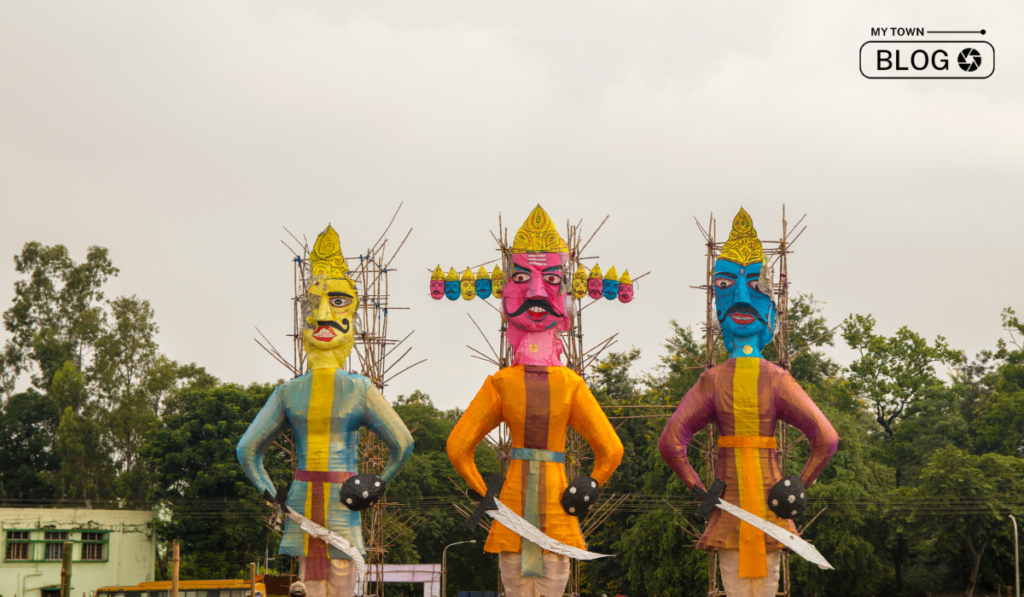Dussehra, also known as Vijayadashami, is one of the most significant and vibrant festivals celebrated in India. It falls on the tenth day of the Navaratri festival and marks the triumph of good over evil. This day carries historical and mythological importance, and its celebration varies across different regions of the country. In this blog, we’ll explore the essence of Dussehra Celebration and how millions of people in India observe it.
The Legend of Dussehra:
Dussehra primarily commemorates the victory of Lord Rama over the demon king Ravana, a central event in the Indian epic, the Ramayana. According to the legend, Lord Rama, with the help of his devotee Hanuman and an army of monkeys, waged a fierce battle against Ravana to rescue his wife, Sita. After a ten-day war, Lord Rama vanquished Ravana and symbolically defeated evil.
The Festive Preparation:
The build-up to Dussehra starts with Navaratri, a nine-night festival dedicated to the worship of the goddess Durga. During this time, homes and public spaces are adorned with colorful decorations, and people engage in dance and music, especially the energetic Garba and Dandiya Raas dances.
The Ramlila Play:
One of the highlights of Dussehra Celebration is the enactment of the Ramlila, a series of plays or performances that depict the life of Lord Rama. These performances often take place in temporary open-air theaters and draw large crowds. The grand finale of Ramlila takes place on Dussehra, culminating in the burning of effigies of Ravana, his brothers, and his kingdom, Lanka.

The Symbolic Victory:
The burning of the effigies is a symbolic representation of the victory of good over evil. It signifies the eradication of hostile forces from our lives and society. The crackling of fireworks and the spectacular display of fire represent the power of righteousness and the defeat of wickedness.
Regional Variations:
Dussehra is celebrated in diverse ways across India. In the eastern state of West Bengal, it coincides with the culmination of Durga Puja, a grand festival celebrating the goddess Durga’s triumph over the demon Mahishasura. In the southern state of Mysore, the Mysore Dasara is marked by a grand procession featuring an elaborately decorated elephant and cultural programs.
Family and Community Bonds:
Dussehra is a time for family gatherings and community celebrations. People exchange gifts, sweets, and good wishes. It’s a time for reflection on the triumph of good values and the importance of righteousness in our lives.
Conclusion:
Dussehra, with its rich cultural and religious significance, showcases the unity and diversity of India. It serves as a reminder that good will always prevail, no matter how powerful evil may seem. The festive spirit, colorful traditions, and the collective celebration of Dussehra make it a cherished and heartwarming experience for people all over the country. It’s a reminder of the eternal truth that light will always dispel darkness, and good will conquer evil.
FAQs
What is the significance of Dussehra?
Dussehra Celebration signifies the triumph of good over evil, notably the victory of Lord Rama over the demon king Ravana, as depicted in the Indian epic, the Ramayana.
When does Dussehra usually occur?
Dussehra falls on the tenth day of the Navaratri festival, typically in September or October. The exact date varies each year based on the Hindu lunar calendar.
How is Dussehra celebrated in different parts of India?
People across India celebrate Dussehra with various traditions and rituals. In the north, the burning of effigies of Ravana is a common practice, while in the east, it coincides with Durga Puja. In the south, Mysore Dasara features grand processions.
What is the role of Ramlila in Dussehra celebrations?
Ramlila is a series of performances or plays depicting Lord Rama’s life and his victory over Ravana. It plays a central role in Dussehra celebrations and concludes with the symbolic burning of Ravana’s effigies.
Are there any particular foods associated with Dussehra?
While there isn’t a specific Dussehra dish, people often prepare and share a variety of sweets and traditional Indian snacks during the festivities. These can include jalebi, laddoos, and samosas.
Is Dussehra a public holiday in India?
Yes, Dussehra is a public holiday in many states of India. On this day, government offices, schools, and businesses typically close.
What are the cultural and social aspects of Dussehra celebrations?
Dussehra is a time for families and communities to come together. People exchange gifts, visit relatives, and participate in cultural events, dances, and music during the festival.
How can Dussehra be celebrated outside India?
Indian communities and people interested in its cultural significance can celebrate Dussehra outside India. They often participate in Ramlila performances, share Indian cuisine, and engage in the spirit of good over evil.
What is the message or lesson of Dussehra for people today?
Dussehra conveys that good deeds, righteousness, and moral values will ultimately prevail over evil. It encourages individuals to uphold the path of virtue and truth.
Are there any safety precautions to consider during Dussehra, especially with fireworks?
Yes, safety is crucial, especially during the fireworks displays on Dussehra. Following safety guidelines and handling fireworks responsibly is essential to prevent accidents and injuries. Additionally, environmental concerns regarding air and noise pollution are becoming increasingly important, so it’s vital to be mindful of the environmental impact of fireworks.








